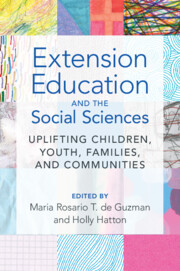Book contents
- Extension Education and the Social Sciences
- Extension Education and the Social Sciences
- Copyright page
- Contents
- Contributors
- Part I Overview of Extension and the Social Sciences
- Part II Addressing Key Issues in the Well-Being of Children, Youth, and Families
- Chapter 5 Extension’s Role in Supporting Young Children’s Well-Being
- Chapter 6 Supporting Youth through Family Engagement
- Chapter 7 The Application of Social Science in 4-H Youth Development
- Chapter 8 Promoting Healthy Behaviors and Communities through Food, Nutrition, and Health Extension Efforts
- Chapter 9 Youth Entrepreneurship Education
- Part III Looking Ahead: Emerging Issues and Trends
- Index
- References
Chapter 6 - Supporting Youth through Family Engagement
Opportunities for Extension
from Part II - Addressing Key Issues in the Well-Being of Children, Youth, and Families
Published online by Cambridge University Press: 28 March 2024
- Extension Education and the Social Sciences
- Extension Education and the Social Sciences
- Copyright page
- Contents
- Contributors
- Part I Overview of Extension and the Social Sciences
- Part II Addressing Key Issues in the Well-Being of Children, Youth, and Families
- Chapter 5 Extension’s Role in Supporting Young Children’s Well-Being
- Chapter 6 Supporting Youth through Family Engagement
- Chapter 7 The Application of Social Science in 4-H Youth Development
- Chapter 8 Promoting Healthy Behaviors and Communities through Food, Nutrition, and Health Extension Efforts
- Chapter 9 Youth Entrepreneurship Education
- Part III Looking Ahead: Emerging Issues and Trends
- Index
- References
Summary
The family is a critical context for youth development. Whether it is through neighborhood, school, or activities, families are critical to determining which spaces youth are accessing and in which spaces they are learning. Some of these determinations are intentional, such as when a parent registers a child to participate in an activity; other determinations are unintentional, such as a neighborhood highway prevents a child from getting to an afterschool activity. Families are also responsible for the more mundane aspects of youth programs such as cost, transportation, and scheduling. Extension is uniquely positioned to support the health and well-being of youth, and in helping meet various challenges through family engagement. Extension has talented staff with skills and expertise in building community partnerships, working within and on behalf of families and communities, and working in partnership with youth, families, and communities to develop new ways of working. This chapter explores ways in which Extension has promoted positive youth development through family engagement and offers new ways of thinking about how Extension might do this work differently going forward.
- Type
- Chapter
- Information
- Extension Education and the Social SciencesUplifting Children, Youth, Families, and Communities, pp. 119 - 136Publisher: Cambridge University PressPrint publication year: 2024



